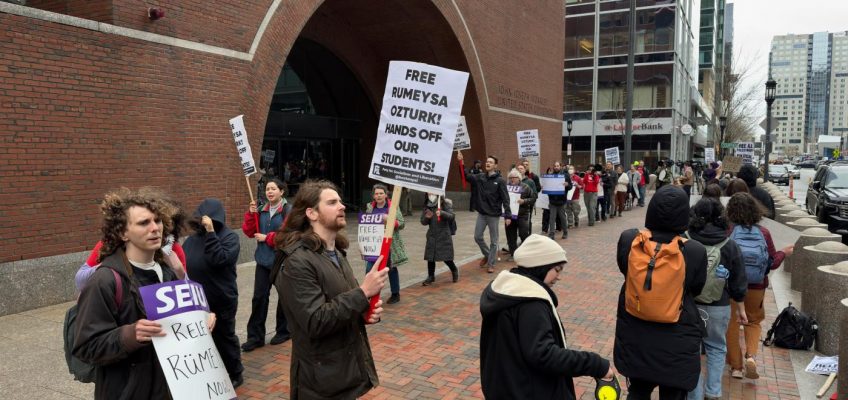By MICHAEL CASEY
BOSTON (AP) — Lawyers for a Tufts University doctoral student from Turkey who was seized by immigration officials off a street near Boston argued in federal court Thursday that she should be returned to Massachusetts, while the U.S. government insisted it did nothing wrong in moving her to a detention center in Louisiana.
Related Articles
States sue to block Trump’s election order, saying it violates the Constitution
Federal judge says she will temporarily block billions in health funding cuts to states
FACT FOCUS: Democratic leaders’ challenge to Trump’s election executive order misrepresented online
Senate confirms Mehmet Oz to take lead of Medicare and Medicaid agency
Judge says US government may have ‘acted in bad faith’ as he weighs contempt over deportation order
Rumeysa Ozturk, 30, was taken into custody as she walked along a suburban street March 25. After being transported to New Hampshire and then Vermont, she was put on a plane the next day and moved to an Immigration and Customs Enforcement center in Basile, Louisiana.
“She was grabbed by federal agents in front of her home and taken over the course of several hours to Vermont without any way to contact counsel or counsel to contact her and with her location for period 22 hours being undisclosed to the Department of Justice attorneys in this case,” Adriana Lafaille, one of her attorneys, told the court.
Ozturk’s lawyers asked U.S. District Judge Denise Casper to order that she be immediately returned to Massachusetts and released from custody. If Ozturk isn’t returned to Massachusetts, Lafaille added, she should be taken to Vermont.
Mark Sauter, a Justice Department lawyer, argued that ICE had a plan for her transport before she was detained and only moved her to Louisiana because there was no bed space for female immigration detainees in New England.
“There was no attempt to manipulate the jurisdiction,” Sauter told the court.
The U.S. attorneys have argued the case should go before an immigration judge.
Ozturk had been moved to Vermont by the time Casper in Boston had ordered authorities to keep her in Massachusetts, they said.
Ozturk’s lawyers said at the time they filed the petition, they had no way of knowing where she was. They have said her detention violates her constitutional rights, including free speech and due process.
Casper issued no immediate decision on the matter after hearing arguments.
Ozturk is among several people with ties to American universities who attended demonstrations or publicly expressed support for Palestinians during the war in Gaza and who recently had visas revoked or been stopped from entering the U.S.
She was one of four students who wrote an op-ed in The Tufts Daily last year criticizing the university’s response to student activists’ demands. The student activists were demanding that Tufts “acknowledge the Palestinian genocide,” disclose its investments and divest from companies with direct or indirect ties to Israel.
On Thursday, her lawyer released a letter from Ozturk in which she talked about her research and said she would continue to stand up against injustice.
“I believe the world is a more beautiful and peaceful place when we listen to each other and allow different perspectives to be in the room,” she wrote.
“Efforts to target me because of my op-ed in the Tufts Daily calling for the equal dignity and humanity of all people will not deter me from my commitment to advocate for the rights of youth and children,” she added.
Outside court Thursday, about 50 protesters chanting “Rumeysa Ozturk Now” and “ICE Out Of Boston” marched and held up signs like one reading: “No More Abductions.”
Recently, two dozen of Ozturk’s colleagues at Tufts University submitted letters to the court backing that request, describing her as a gentle, compassionate and cherished member of the Tufts community.
Reyyan Bilge, a close friend who collaborated with Ozturk on research, was present in court Thursday and described her as a “wonderful student, a wonderful human being.”
“It’s like a nightmare,” she said. “Who would have thought? She came here to do her job as a student, as an exceptional student … Out of the blue, she was taken for doing nothing wrong, How would you feel if you were to be either your daughter, or your niece, or like someone that’s close to you?”
A Department of Homeland Security spokesperson confirmed the termination of Ozturk’s visa last week. The official said investigations found she had engaged in activities in support of Hamas, a U.S.-designated terrorist group, but provided no evidence.
Hamas invaded Israel on Oct. 7, 2023, killing about 1,200 people, mostly civilians, and seizing about 250 hostages. Israel’s retaliatory offensive has killed more than 50,000 people, according to Gaza’s Health Ministry, and destroyed much of the enclave.
Associated Press writers Kathy McCormack and Holly Ramer contributed from Concord, New Hampshire.




